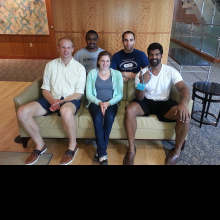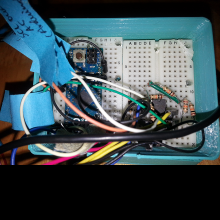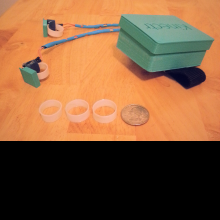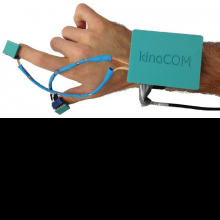The KinoCOM Team: Ravi Chacko, Kendall Gretsch, Sophie Jacobson, Stephen Linderman, Inema Orukari, Will Padovano, Joshua Siegel, and Avik Som
JB was a computer programmer. One day, when he was 45 years old, he was shaving his face when he suddenly lost consciousness and fell to the floor. His wife soon found him and took him to the hospital, but by then his stroke had left him almost completely paralyzed in all four limbs and some of his neck. Several years later, we met JB in the classroom after a lecture on paralysis and treatment. In order to type, and thereby communicate, JB was using a small clicker under his right hand. JB’s wife was with him, and as you might imagine, she was doing most of the speaking for him. After the presentation, a few of us went up to talk with them more. JB’s wife explained that out of all the challenges JB faced, the most frustrating was the time it took him to complete a sentence on his laptop. It prevented him from participating in conversations with his friends and family.
As JB and his wife began heading home, a group of us stayed and continued talking. We felt certain that there must be more efficient and powerful ways for him communicate and control his computer. We talked about new technologies that we had seen and how a simple, flexible microcontrolled device could improve his communication. As we explored resources to help solve this patient’s problem, our professor told us about the microMedic contest. Using a microcontroller and two motion sensing accelerometers, we designed an inexpensive but effective device to expand JB’s methods of communication from just using a single click to controlling a computer cursor.
Beyond applications for JB, we see the potential for this technology to improve the quality of life of veterans and patients with a wide range of disabilities. The device that we created is uniquely suitable for patients with partial paralysis or missing limbs because it can be controlled by other parts of the body that are capable of movement. We call our device “kinoCOM” because it translates motion into communication.
These days, the ability to use a computer mouse is equivalent to the ability to communicate. It affords the ability to control your television, your wheelchair, your thermostat, and a range of other devices. With computer access comes access to an ever growing and improving repertoire of applications. Before his stroke, JB was a computer programmer. Restoring his ability to manipulate a cursor will improve his quality of life. As our military becomes increasingly computerized, computer interface technologies such as the kinoCOM can not only increase the quality of life of wounded veterans, but may allow them to continue to serve.




